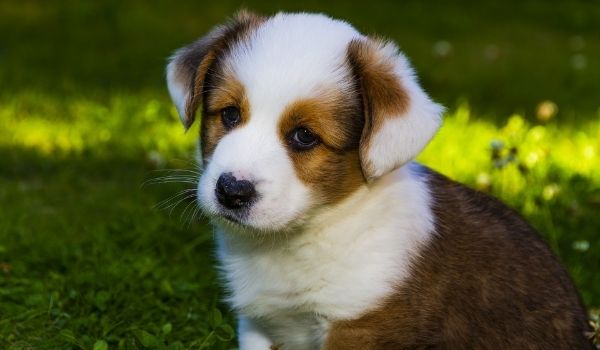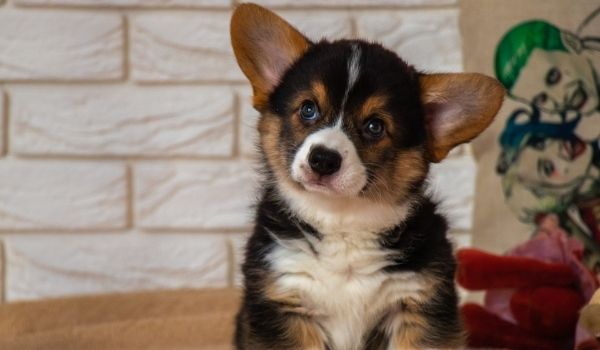Did you just bring home a Corgi puppy? Are you wondering how big your Corgi will get and what development changes would it go through? Corgi puppies are one of the most popular small dog breeds—they are known for their petite size and apartment friendliness.
They are loved by Queen Elizabeth and by Americans as well—as of the 2020 AKC ranking, Corgi is the 11th most popular dog breed. Besides their small size, their popularity is attributed to their smiling faces, round butts, and overall cheerful and affectionate nature. Because of their soaring popularity, scores of Corgi mix breeds have been developed by crossbreeding Corgis with other dog breeds. For instance, Corgis are crossed with Australian Cattle dogs to create Cowboy Corgi, with Australian Shepherd to have Auggie, Husky to have Horgski), and so on.
Like other puppies, Corgi puppies also undergo many developmental changes as they grow, requiring special care and attention. If proper care is not provided, your Corgi may experience improper growth. While it is hard to know if your Corgi puppy is growing properly or not, having a Corgi growth chart will help you keep track and identify if something is out of sorts.
Corgi Breed Overview
Despite being small, Corgis are highly energetic and live an active lifestyle. They are herding in nature, loyal, and protective of their families. They are quite friendly, intelligent, and always up for adventures. Due to these reasons, this dog breed is experiencing unprecedented popularity among dog lovers.

Corgi Growth Chart
Corgi puppies grow and accumulate weight rapidly during the first half-year. After that, they slow down and eventually stop growing after their first birthday. Females are behind males—they are smaller in height and lesser in weight. Similarly, males take 14 months to grow completely, while females reach their maximum growth limits in 12 months.
| Age | Size (inches) | Size (inches) | Weight (pound) | Weight (pound) |
| Male | Female | Male | Female | |
| At Birth | 1.5 to 2 | 1.5 to 2 | 0.6 | 0.6 |
| 2 Weeks | 3 | 2 to 3 | 1 to 2 | 1 to 2 |
| 1 Month | 4 | 4 | 4 to 7 | 4 to 7 |
| 2 Months | 4 to 6 | 4 to 5 | 8 to 11 | 8 to 10 |
| 3 Months | 5 to 7 | 5 to 6 | 9.5 to 12.5 | 9.5 to 12 |
| 4 Months | 5 to 8 | 5 to 7 | 13 to 17 | 13 to 16 |
| 5 Months | 6 to 8 | 5 to 8 | 15 to 21.5 | 15 to 20 |
| 6 Months | 7 to 8 | 7 | 17 to 25 | 17 to 24 |
| 7 Months | 8 to 9 | 7 to 9 | 19.5 to 25 | 19.5 to 24 |
| 8 Months | 9 | 8 to 9 | 20 to 27 | 20 to 26 |
| 9 Months | 9 to 10 | 9 | 21 to 27.5 | 21 to 27 |
| 10 Months | 9 to 10 | 9 to 10 | 22 to 28 | 22 to 27 |
| 11 Months | 10 to 11 | 9 to 10 | 23 to 29 | 23 to 28.5 |
| 1 Year | 10 to 12 | 10 to 11 | 23 to 30 | 23 to 29 |
Based on the Corgi growth chart, the growth pattern of the breed can be divided into five distinct stages:
Birth to Two Weeks
The newborn Corgis are very small and fragile: they do not even have a full pound of mass and are no more than two inches in size. Even their eyes are closed at the time of birth—Corgi puppies take around 10 to 14 days to open their eyes. During the first half month, the newborns do not acquire more than an inch of height; however, their weight increases threefold and reaches up to two pounds. There is no considerable difference in growth patterns between males and females at this stage.
At this stage, the puppies are entirely subjected to their mother for food, milk, care, and cleanliness. They also lack the strength to move any part of their body; nevertheless, they start walking on all fours slowly by the end of this stage.

Two Weeks to Three Months
Corgi puppies almost double their size during this stage, reaching up to seven inches. However, their weight gain is much swifter as it increases six times, reaching 12 pounds. Meanwhile, considerable differences in growth patterns between males and females also begin to surface. By the end of the stage, females can be an inch smaller and half a pound lesser than their male counterparts.

This is the optimum stage for you to start training your Corgi and take him for vaccinations. A puppy undergoes the following changes during this stage:
- He starts socializing with his mother and siblings.
- His senses begin working.
- His teeth start popping out.
- He kicks off walking and barking.
Three to Six Months
At this stage, puppies gain about seven inches of height; nevertheless, their weight doubles, reaching 25 pounds. Males are an inch larger and a pound heavier by the end of this stage.
Corgis are quite energetic at this stage, but they still have frangible bones for too much exercise and workouts. They may have a burst of fear phases. This is the perfect time for owners to buy their pups some chew toys because they tend to chew on anything that comes their way. You should also get a crate for your Corgi and begin puppy crating so that he can take refuge in his crate whenever he is feeling anxious.
Six to Nine Months
During this stage, male puppies reach 10 inches and females around nine inches. Their weight tallies up to 27.5 pounds for males and 27 for females. By this time, you should have begun socialization training of your Corgi puppy so that he is friendly towards strangers and gets along with children as well as other pets.
Nine-Month to Onwards
After a year of their birth, Corgis become adults and reach their maximum height and weight – 12 inches and 30 pounds, respectively. Like in previous stages, males tend to be larger and heavier. They exhibit all characteristics of a full-grown puppy, and they are also able to reproduce. By the end of the first year, they should be able to have a proper diet and do regular workouts.

Factors Affecting the Corgi Growth
Corgi is overall a healthy dog breed, and mots Corgi live a healthy life without experiencing any serious health issues. But there are some common Corgi health issues that may afflict your dog, affect their lifespan and growth. Below, we have discussed various factors that may interfere with normal Corgi growth.
Gender
As already discussed, gender plays a bigger role in Corgi’s growth, just like in almost every other breed. Males have more height and are heavier than females throughout all the stages of growth. In adults, male Corgis are on average an inch taller and a pound heavier than their female counterparts.
Neutering
Neutering refers to the removal of the capacity to reproduce. According to recent studies and research, neutering does not negatively impact dogs’ growth patterns. However, sexual hormones play an important role in the overall growth of dogs, and neutering them too early might hinder their growth pattern. Therefore, dogs must undergo neutering before their sexual organs are fully developed. This means that you should neuter your dog before he hits puberty.
Genetics
Just like in the case of human beings, the factor of genetics plays a dominant role in dogs. If the parents of your dogs were short or underweight, you might expect your Corgi to be the same, and vice versa. Similarly, your Corgi puppy may have inherited some of the most common Corgi health issues from his parents, which could interfere with his normal growth and development.
Diet
Malnutrition can cause stunting in any living being, and dogs are no exception. Puppies need a balanced and appropriate amount of all nutrients in their diet to properly grow their bones and muscles. Protein plays the most important role. While quality dog foods contain ample protein content, you can also try feeding chicken, crab, turkey, etc., to your Corgi in small amounts as a treat. If your Corgi does not have enough intake of all nutrients, chances are that he may experience stunted growth.
Worms
Hookworms and roundworms are mostly responsible for stunting in dogs due to worm infection. Worms can eat enough portion of your dog’s diet, which can deprive him of proper height and weight gain.
Portosystemic Shunt (PSS)
It is a liver disease that can affect your Corgi’s growth negatively. The blood bypasses the liver and flows straight into the systemic circulation. Besides stunting, it can also cause weight loss in dogs. His life expectancy may also decrease.

Overweight and Obesity in Corgis
Like other dogs, the Corgis are also prone to gain weight and fat in more than the normal quantity. To tell if your dog is overweight or not, simply compare his weight to the above Corgi growth chart. If your dog weighs more, he is overweight, and you need to cut down on his caloric intake.
Causes of Obesity in Corgis
There is no specific cause for unnecessary fat in the Corgis. Some of the causes responsible are:
- Overeating: Eating too much can disturb the balance of proper diet that can cause too much intake of calories, fats, and sugar, causing dogs to accumulate fat.
- Improper Diet: A diet high in calories can cause excessive weight gain in a short amount of time. Even if the diet is healthy, you should not overfeed your dog.
- Inactivity and Laziness: The lack of daily exercise and physical activities can hinder dogs’ calorie- and fat-burning process, causing his body to stockpile those nutrients.
Remedies of Obesity in Corgis
If your dog is overweight, you can resort to the following solutions for removing the excess fat from his body:
- Regular Exercise: Physical activities daily can help burn the surplus of fat and calories in your canine’s body. You can take your dog for regular walks.
- Maintaining a Balanced Diet: A diet with only an appropriate amount of calories, fat, and carbohydrates can ensure that your dog does not get overweight. If you are training an overweight Corgi, you can try ways to train a dog without treats.
- Consulting a Vet: You must consider consulting a vet if your dog is abnormally high in weight or if the above remedies seem to be ineffective.
